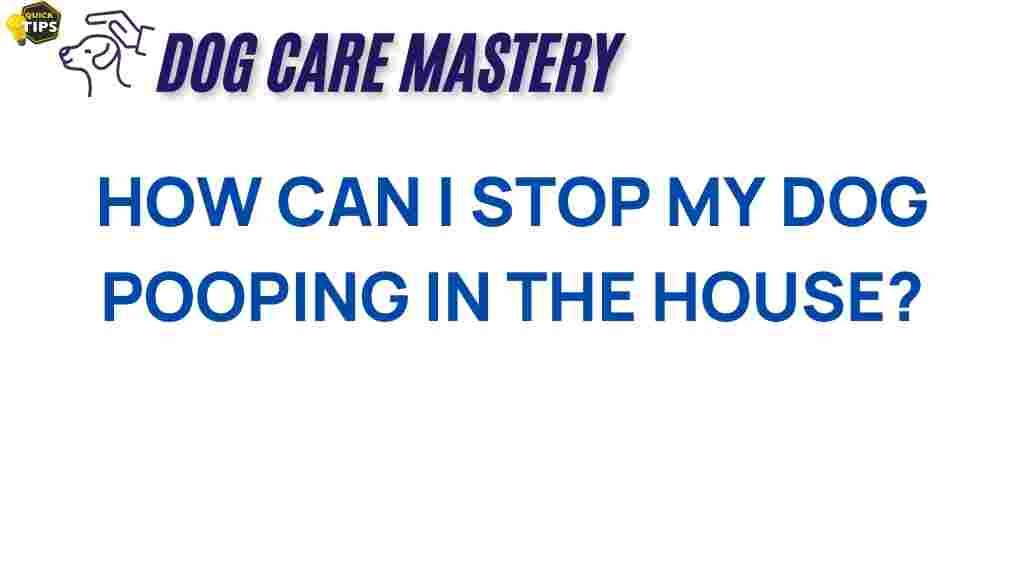Dog Training: Unraveling the Mystery of Indoor Pooping
Dealing with a dog that poops indoors can be a frustrating experience for any pet owner. This behavior not only complicates the daily routine but can also lead to stress and embarrassment. Understanding how to effectively manage this issue is crucial for maintaining a harmonious home environment. In this article, we will explore comprehensive dog training techniques and strategies to help you stop your dog from pooping indoors.
Understanding the Behavior
Before diving into solutions, it’s important to understand why your dog might be pooping indoors. Here are some common reasons:
- Medical Issues: Health problems such as gastrointestinal issues can lead to indoor accidents.
- Stress or Anxiety: Changes in environment, new family members, or loud noises can cause stress.
- Lack of Opportunity: If your dog isn’t taken outside frequently enough, they may have no choice but to relieve themselves indoors.
- Incomplete Training: Puppies and adopted dogs may not have had proper house training.
Step-by-Step Process to Stop Indoor Pooping
Now that we understand the potential causes, let’s delve into a structured dog training plan to eliminate indoor pooping.
1. Establish a Routine
Dogs thrive on routine. Establishing a consistent schedule for feeding, potty breaks, and exercise can greatly reduce indoor accidents.
- Feeding Schedule: Feed your dog at the same times every day. This helps regulate their digestive system.
- Potty Breaks: Take your dog outside immediately after meals, upon waking, and before bedtime.
- Exercise: Regular walks can stimulate your dog’s bowels, making them more likely to poop outside.
2. Positive Reinforcement
Reward your dog for doing their business outdoors. This encourages them to associate going outside with positive outcomes.
- Praise: Give verbal praise immediately after they poop outdoors.
- Treats: Offer a small treat as a reward for successful outdoor pooping.
- Playtime: Engage in a fun activity after they relieve themselves outside.
3. Supervision and Confinement
When you cannot supervise your dog, consider confining them to a smaller area or using a crate.
- Crate Training: Dogs typically avoid soiling their sleeping area. A properly sized crate can help with training.
- Supervised Areas: Use baby gates or pens to limit your dog’s access to the house when you are unable to watch them closely.
4. Clean Accidents Thoroughly
If your dog has an accident indoors, it’s essential to clean the area thoroughly. Use an enzyme-based cleaner to eliminate odors that may attract them back to the same spot.
5. Monitor Behavior
Pay attention to your dog’s behavior. Signs they need to go out include:
Troubleshooting Tips
Even with the best dog training efforts, accidents may still happen. Here are some troubleshooting tips to help you manage the situation:
Identifying Triggers
Take note of when and where your dog tends to have accidents. Identify patterns that may help pinpoint the cause.
Consulting a Veterinarian
If your dog continues to poop indoors despite your efforts, it might be time to consult with a veterinarian. They can rule out any underlying health issues.
Seeking Professional Help
Consider enlisting the help of a professional dog trainer or behaviorist if you’re struggling to resolve the issue on your own. Their expertise can provide tailored solutions to your specific situation.
Conclusion
Stopping your dog from pooping indoors requires patience, consistency, and a solid dog training plan. By establishing a routine, using positive reinforcement, and monitoring your dog’s behavior, you can effectively train your dog to relieve themselves outdoors. Remember to clean any accidents thoroughly and seek professional help if needed. With dedication and time, you can unravel the mystery of indoor pooping and create a more enjoyable living environment for both you and your furry friend.
For more tips on dog training and behavior management, check out this comprehensive guide. Also, consider visiting The American Kennel Club for additional resources on canine training and care.
This article is in the category Behavior and created by dogcaremastery Team
